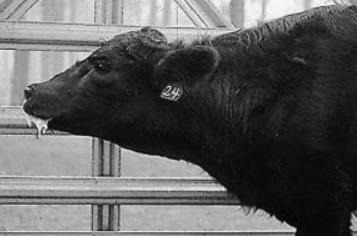By Dr. Michelle Arnold
Poisonous plants can be responsible for considerable losses in livestock although many cases go unrecognized and undiagnosed due to a lack of knowledge of which plants are dangerous and the wide range of signs that may be observed after consumption. The risk posed to animals by a particular plant depends on a variety of factors, including how much of the plant is consumed and over what time period; the stage or maturity of plant growth; which parts of the plant are eaten; whether the plant is green or dried; and the animal’s age, species, and in some cases breed. Most weeds are tough and unpalatable, and cattle will not consume them unless baled in hay or the pasture is limited due to drought or overgrazing and there is little else to consume.
If cattle on pasture suddenly develop symptoms such as diarrhea, salivation or slobbering, muscle weakness, trembling, incoordination, staggering, collapse, difficulty breathing, or rapid death, then poisoning due to plants or any number of other toxicants should be high on the list of possible causes.

Perilla mint (Perilla frutescens), aka perilla, purple mint, mint weed, beefsteak plant, and wild coleus.
Oftentimes poisonous plants affect just a few cattle in the herd. Cases occur more often shortly after animals are moved to a new field. The severity of signs primarily depends on how much of the plant or other toxicant is consumed over what time period (the rate of consumption). If plant poisoning in livestock is suspected, the first thing to do is call a veterinarian, since prompt treatment is critical to the animal’s chances of survival. Until the veterinarian arrives, keep the affected animal quiet and confined where a physical examination can be performed, and treatment given. Other animals should be moved as carefully as possible from the pasture where the suspected poisoning occurred until the cause of illness has been determined. Prevention involves learning to recognize poisonous plants, implementing effective weed control and pasture improvement, and offering supplemental forage or feed when pasture is limited so cattle are not forced to graze toxic weeds. A common summer weed in Kentucky that can cause problems in livestock is perilla mint (Perilla frutescens), also known as perilla, purple mint, mint weed, beefsteak plant, and wild coleus. Severe lung damage can result from ingestion of the leaves and seeds, resulting in “atypical interstitial pneumonia” or AIP. Perilla is a summer annual that thrives in late summer when pastures are frequently dry and dormant. The opposite ovate leaves attached to square stems can be dark green to purple with toothed leaf margins.

Perilla mint has a distinctive mint aroma, with opposite dark green to purplish leaves that have serrated leaf margins attached to square stems. Mature plants reach 2-3 feet tall and produce small, white to purple flowers with abundant seeds. Pictures courtesy JD Green
Perilla reaches 20 to 30 inches in height at maturity with opposite leaves. The white to whitish-purple flowers and subsequent seed which occur in late summer are attached to terminal spikes. The plant also has a distinct, minty odor, especially as it becomes more mature. The weed prefers shaded areas along creeks, in fence rows, and the edges of the woods and partially shaded pastures. Once it becomes established, perilla produces many seeds and large colonies can develop in succeeding years. The early pre-seed stage of the weed is of relatively low toxicity while the flowering and green seed stage plant is most toxic, especially the seeds themselves. The time of year when perilla reaches the seed stage often corresponds to periods when desirable pasture grasses are scarce and the weather is hot, enticing cattle to consume plants they normally avoid, especially those in shady areas. The flowering or seed parts of perilla mint contain the highest concentration of toxic agents, perilla ketones. Perilla ketones are toxic in both fresh plants and in hay. Once ingested, they are absorbed into the bloodstream and carried to the lungs. Within the lungs, perilla ketones and other similar compounds are then activated, damaging the cells lining the air sacs and severely impairing gas exchange and lung function. This lung damage causes the animal to develop acute respiratory distress syndrome (ARDS), a sudden and dramatic onset of severe breathing difficulty. Treatment is of limited value and severe cases seldom survive.

Photo used with permission from Dr. Alan Doster, University of Nebraska-Lincoln.
The clinical signs of acute respiratory distress syndrome include a sudden onset of open-mouth breathing with the head and neck extended, nostrils dilated, a sway-back appearance, tongue protruding with foam coming from the mouth, an open-shouldered stance, and sometimes aggression. Breathing is shallow and rapid (35-75 breaths per minute) and may have a loud expiratory grunt. Temperature is typically normal but may be mildly elevated due to the severity of the condition. In extreme cases, air under the skin (subcutaneous crepitation) may be felt over the upper portions of the neck, shoulders and back. Mild exercise may cause the animal to collapse and die. Generally, there is an absence of coughing and no signs of infection such as fever or depression unless a secondary bacterial pneumonia develops. Severely affected animals usually die within 1-2 days but animals that survive may develop chronic lung damage or heart failure. The stress of handling can cause prompt death so treatment must be approached with caution. A dart gun may be necessary to avoid moving the animal to a treatment facility. Treatments administered or prescribed by a veterinarian may include diuretics, nonsteroidal anti-inflammatory medications and corticosteroids used in an extra-label manner.
At necropsy, atypical interstitial pneumonia (AIP) is recognized when the chest cavity is opened, because the lungs remain fully expanded, sometimes with rib indentations on them, rather than collapsed as with a normal lung. AIP-affected lungs are heavy with a firm, rubbery texture instead of the expected light and spongy lung tissue. These necropsy findings are confirmed microscopically as a very distinct pattern of damage to the lung cells. In addition, the leaves and distinct square stems are sometimes identifiable in rumen contents.
The best time of the year to begin scouting for perilla mint is late spring (May and June). During the late summer months when plants are flowering and producing new seed, grazing infested fields should be limited. Mowing can be used for control but must be timely to reduce new seed production. Unfortunately, mowing or clipping fields may not be feasible in some areas since many plants grow near trees and in fence lines. Chemical control options include herbicides labeled for use in pastures and hay fields that consist of single or premixed active ingredients of 2,4-D, dicamba (e.g., Weedmaster®, Rifle-D®, Brash®, etc.), triclopyr (eg. Crossbow®, etc.) or aminopyralid (e.g., DuraCor®, GrazonNext®). For best results, herbicide applications should be made to smaller, actively growing plants. Control is likely to be less effective when applied to taller, flowering plants. Grazing animals should be removed for a while after herbicide treatment since they may be more attracted to dying perilla mint plants. Furthermore, use good stewardship and observe label precautions when applying herbicides.
Prevention begins with learning to recognize poisonous plants, where they grow, and when they cause problems. Toxic weeds may be found in fence rows, along creek or stream banks, near ponds and in the woods although some (such as cocklebur, horsenettle and pigweed) are found in pastures and hayfields. Scout summer pastures and offer supplemental forage or feed when pasture is limited so cattle are not forced to graze toxic weeds. Do not harvest toxic weeds in hay or silage since cattle do not sort through these feedstuffs and will readily ingest the weeds. Most importantly, implement effective weed control at the right time and use management practices to thicken the stand and improve the growth of desirable forages which can compete with the emergence and growth of annual weeds.
Source : osu.edu